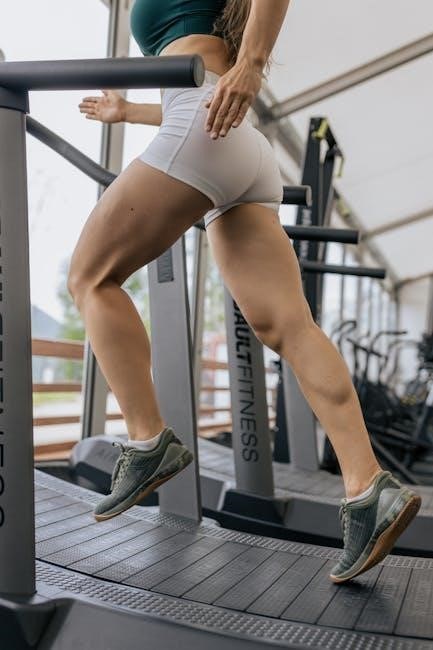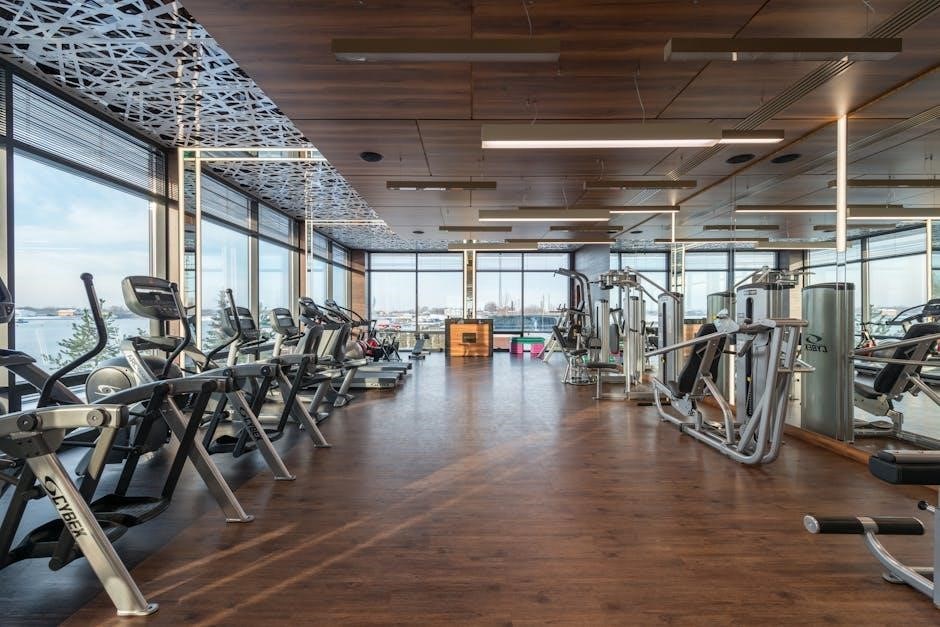A manual treadmill is a user-powered fitness device designed for walking, jogging, or running indoors. It operates without electricity, relying on the user’s movement to drive the belt.
1.1 Definition and Purpose
A manual treadmill is a fitness device that requires the user to generate motion by walking, jogging, or running. Unlike electric treadmills, it operates without a motor, relying solely on the user’s effort to move the belt. Its primary purpose is to provide a low-impact, efficient workout for improving cardiovascular health, building endurance, and strengthening muscles. Manual treadmills are ideal for those seeking a cost-effective, space-saving alternative to motorized models, offering a natural, user-driven exercise experience.
1.2 Brief History and Evolution
Manual treadmills have origins dating back to the 19th century, initially used in prisons as a form of hard labor. Over time, their purpose shifted from punishment to fitness. By the mid-20th century, manual treadmills became popular for physical training, offering a simple, low-cost alternative to motorized models. Modern designs incorporate improved materials and safety features, enhancing durability and user experience. Their evolution reflects a growing emphasis on functional, eco-friendly fitness solutions, making them a staple in home and professional workout spaces today.

How Manual Treadmills Work
Manual treadmills function through user-generated motion, where walking or running powers the belt, typically assisted by a flywheel for smooth movement. No electricity is required.
2.1 Mechanism and Design
Manual treadmills feature a belt and deck system powered by user movement. A flywheel smooths motion, while rollers minimize friction. The design includes a sturdy frame, often foldable, and basic controls for tracking progress. Safety features like side rails are common. The mechanism relies on the user’s effort to propel the belt, making it eco-friendly and cost-effective compared to electric models. The design emphasizes durability and simplicity, ensuring a low-maintenance workout experience. This structure allows for effective cardiovascular and muscular engagement without reliance on electricity.
2.2 User-Driven Motion
Manual treadmills operate solely through the user’s movement, requiring physical effort to propel the belt. The lack of electric assistance means the user controls the speed and intensity. As the user walks or runs, their motion drives the belt, engaging the flywheel to maintain smooth movement. This design eliminates the need for electricity, making it eco-friendly and portable. The user’s effort directly translates into the workout, ensuring a more engaging and effective exercise experience. This mechanism also allows for a natural stride and pacing, tailored to individual preferences and fitness goals.

Benefits of Using a Manual Treadmill
Manual treadmills offer enhanced caloric burn, improved muscle engagement, and a robust cardiovascular workout. They promote energy efficiency and provide a cost-effective, eco-friendly fitness solution for home use.
3.1 Increased Caloric Burn
Manual treadmills are known to burn up to 30% more calories compared to electric treadmills. This is because users must generate the motion themselves, engaging more muscle groups to propel the belt. Without motor assistance, the body expends additional energy to maintain movement, particularly in the legs, core, and upper body. The lack of assistive forces means every step requires active effort, leading to higher energy expenditure. This makes manual treadmills an excellent choice for those seeking an intense workout to lose weight or improve endurance. The continuous motion also prevents rest periods, further enhancing caloric burn.
3.2 Improved Muscle Engagement
Manual treadmills enhance muscle engagement by requiring users to generate motion through their own effort. Unlike electric treadmills, which assist movement with a motor, manual models demand active participation from the legs, core, and upper body. This increased engagement strengthens muscles more effectively, as the body must work harder to propel the belt. The continuous effort improves endurance and builds strength without relying on mechanical assistance. Additionally, the natural gait and resistance provided by manual treadmills promote better posture and overall physical coordination, making them ideal for those seeking a more immersive workout experience.
3.4 Enhanced Cardiovascular Workout
Manual treadmills provide an enhanced cardiovascular workout by requiring consistent effort to maintain motion. Unlike electric treadmills, they lack a motor, so users must generate power through their strides, increasing heart rate and boosting cardiac output. This sustained effort improves heart health by strengthening the cardiovascular system. The absence of external assistance ensures a more challenging and effective workout, promoting better circulation and endurance. Regular use can lead to improved overall fitness and a stronger heart, making manual treadmills a superior choice for those seeking intense cardio training without reliance on electric assistance.

Manual vs. Electric Treadmills
Manual treadmills require user propulsion, offering a quieter, cost-effective option with higher caloric burn, while electric treadmills provide preset programs and speed control for convenience and variety.
4.1 Key Differences
Manual treadmills are non-motorized, requiring users to power the belt with their own movement, while electric treadmills rely on a motor for operation. Manual models are generally quieter, more affordable, and require less maintenance. They also tend to be more compact and portable. Electric treadmills, however, offer preset programs, incline adjustments, and advanced features like heart rate monitoring. Manual treadmills often provide a more intense workout due to the lack of assistance, while electric treadmills offer convenience and versatility for diverse training needs. The choice depends on personal preferences, fitness goals, and available space.
4.2 Pros and Cons Comparison
Manual treadmills offer a cost-effective, space-saving solution with no electricity required, promoting a more intense workout. They are quieter and environmentally friendly. However, they lack advanced features like preset programs and incline adjustments. Electric treadmills provide convenience, customizable workouts, and additional safety features but are more expensive and bulky. Manual models are ideal for those seeking simplicity and a challenging workout, while electric treadmills suit users who value versatility and advanced training options. Both options cater to different fitness goals and preferences, making the choice dependent on individual needs and priorities.

Physics Behind Manual Treadmills
The physics of manual treadmills involves converting user effort into motion through friction and inertia, requiring continuous energy input to sustain belt movement without motor assistance.
5.1 Force and Motion Dynamics
Manual treadmills rely on Newtonian mechanics, where the user’s force drives the belt’s motion. The absence of a motor means the runner must generate and sustain movement, increasing energy expenditure. Friction and inertia play crucial roles, as the user must continuously apply force to overcome resistance. The interplay of gravitational force, normal force, and horizontal propulsion force ensures the treadmill operates efficiently. This dynamic requires more physical effort compared to motorized treadmills, making manual treadmills a more calorie-intensive option for fitness enthusiasts.
5.2 Energy Expenditure Explained
Manual treadmills require the user to generate motion entirely through their own effort, resulting in higher energy expenditure. Since there’s no motor, the runner must convert chemical energy from food into kinetic energy to move the belt. This process involves overcoming friction and inertia, which demands more physical work. Studies indicate that manual treadmills can burn up to 30% more calories compared to electric treadmills, as the user’s energy is solely responsible for propulsion. This makes manual treadmills a highly efficient tool for cardiovascular workouts and weight loss, engaging more muscle groups and requiring constant effort to maintain motion.

Maintenance and Safety Tips
Regular lubrication of moving parts and checking for wear and tear ensure smooth operation. Always ensure the treadmill is on a level surface and use safety features like emergency stops.
6.1 Regular Maintenance Practices
Regular maintenance ensures optimal performance and longevity of a manual treadmill. Lubricate the belt and rollers every 50 hours of use to reduce friction and prevent wear. Inspect the deck and frame for damage or rust, addressing issues promptly. Tighten bolts and screws regularly to maintain stability. Clean the walking surface and handlebars with a damp cloth to prevent dirt buildup. Store the treadmill in a dry, cool place to avoid moisture-related damage. Proper care extends the life of the equipment and ensures safe workouts.
6.2 Safety Precautions
When using a manual treadmill, prioritize safety to avoid injuries. Always start with a slow pace and gradually increase speed. Ensure the workout area is clear of obstacles. Wear proper footwear and avoid loose clothing that could catch on moving parts. Hold the handrails for stability, especially during intense workouts. Keep children and pets away while in use. Inspect the treadmill before each session to ensure all parts are secure and functioning properly. Avoid overexertion and stay hydrated. Following these precautions ensures a safe and effective workout experience;

Choosing the Right Manual Treadmill
Selecting the right manual treadmill involves considering factors like durability, size, and features. Look for sturdy frames, smooth belt systems, and adjustable incline options for varied workouts.
7.1 Factors to Consider
When selecting a manual treadmill, consider durability, size, and features. Durability involves a sturdy frame and high-quality bearings for smooth operation. Size should fit your space and user height. Features like adjustable incline, heart rate monitors, and transportation wheels enhance functionality. Noise level is another factor, as quieter models are ideal for home use. Budget is crucial, balancing cost with desired features. Reading reviews and comparing models helps ensure the best fit for your fitness goals and space constraints.
7.2 Top Models and Reviews
Top-rated manual treadmills include the Walkolution Treadmill, known for its durability and smooth operation. The Peloton Tread is another popular choice, offering a compact design and robust features. Reviews highlight the Exerpeutic TR3300 for its manual incline adjustment and sturdy construction. The ProForm City L6 is praised for its space-saving design and affordability. When choosing, consider user feedback on performance, noise levels, and ease of assembly. Reading detailed reviews helps identify the best model for your fitness goals and budget, ensuring a worthwhile investment in your home workout routine.
